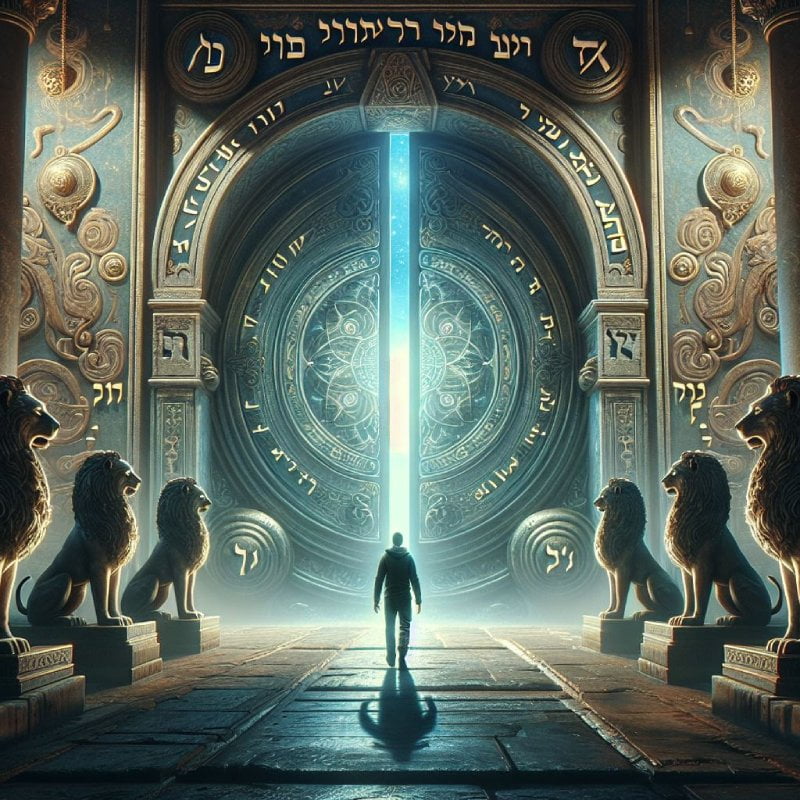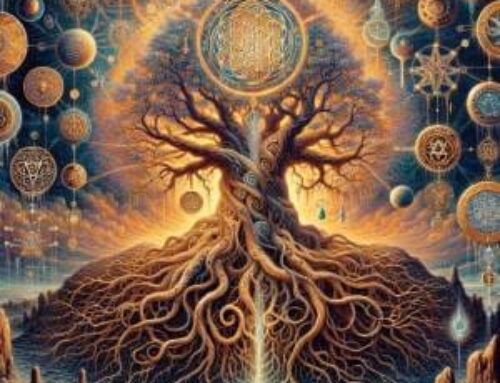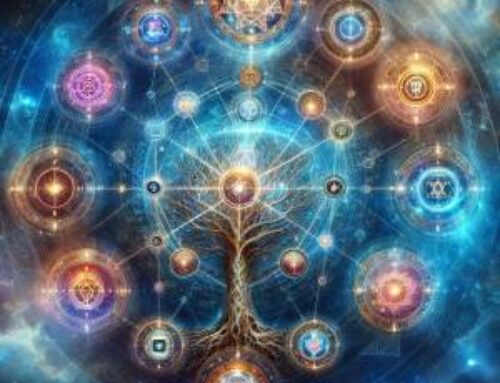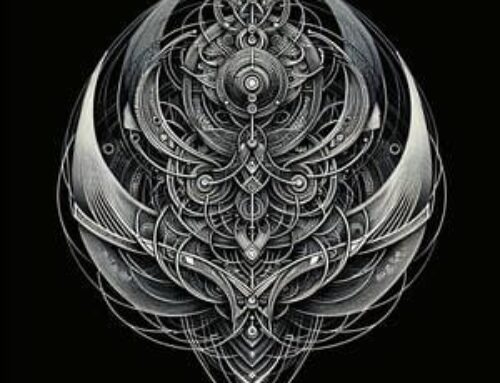Contents
- 1 Introduction to Kabbalah on Death
- 2 The Mystical Purpose of Death in Kabbalah
- 3 The Journey Through the Sephiroth: Understanding Life and Afterlife
- 4 The Cycle of Soul Rectification: Tikkun and Reincarnation
- 5 Death and the Kabbalistic Tree of Life: A Pathway to Immortality
- 6 Conclusion of “Kabbalah on Death”
- 7 “Kabbalah on Death” uncovers the Spiritual Laws of Death
- 8 FAQ – Kabbalah on Death
- 9 References:
Introduction to Kabbalah on Death
Explore the profound teachings of Kabbalah on Death and its implications for spiritual growth. In the intricate doctrines of Kabbalah, death transcends mere cessation of life, emerging as a critical juncture for spiritual metamorphosis. This mystical tradition views the end of physical existence not as a finale but as a pivotal transition, facilitating the soul’s ascension and purification in its quest for immortality. This article explores the profound kabbalistic interpretations of death, where each demise is understood not just as an end, but as a necessary passage that leads to higher spiritual realms. Explore the profound insights of ‘Kabbalah on Death’ as we delve into its mystical interpretations.

Through the esoteric framework of the Tree of Life and the cycles of Tikkun, or soul rectification, Kabbalah presents a unique lens to view death. These teachings depict the soul’s journey across various incarnations, with death acting as a portal to greater enlightenment and a deeper understanding of the universe’s intricate workings. Here, the Sephiroth play a crucial role, mapping out the stages of the soul’s evolutionary trek through life, death, and beyond.
Kabbalah on Death reveals unique perspectives on the soul’s journey after life. As we delve into these sacred texts, we uncover kabbalistic insights that offer a richer, more nuanced understanding of life’s ultimate transition. This exploration not only illuminates the soul’s pathway through the mysteries of death but also provides a source of solace and inspiration for those grappling with the inevitabilities of life and death. Join us as we traverse this mystical landscape, shedding light on the kabbalistic vision of death as a transformative experience essential for the soul’s eternal journey.
The Mystical Purpose of Death in Kabbalah
The Mystical Purpose of Death in Kabbalah
Kabbalah on Death’ teaches that mortality is a vital transition, offering a deeper understanding of our spiritual journey. In the profound depths of kabbalistic teachings, death is depicted not as an extinguishment but as a vital transformation, a necessary phase for the soul’s evolution. Kabbalah, an ancient Jewish mystical tradition, articulates that death is a gateway through which the soul passes to return to its divine origins, purifying and preparing for a higher existence. Death is like birth, the dying of the old existence and the entering into a new experience of consciousness. When we incarnate we are born, but it is also a death because we leave the old dimension of the womb. So death is also a necessary aspect of life.
Understanding the Transition
Kabbalah elucidates that life and death are intertwined; one cannot exist without the other, much like the light only exists with shadow. Death, in this mystical context, is the soul’s release from the physical constraints of the body, enabling a return to its spiritual essence. This transition is viewed as an opportunity for the soul to achieve Tikkun, or rectification, an essential process where the soul is purified and prepared for its eventual reintegration with the Infinite Light.
The Role of Death in Spiritual Ascension
Understanding ‘Kabbalah on Death’ can transform our perception of life’s final passage. The teachings of the Zohar, a foundational work in the study of Kabbalah, suggest that through death, the soul experiences a rebirth. It is a cleansing process that frees the soul from any spiritual impurities accumulated during its earthly existence. This concept is pivotal as it underscores the cyclic nature of life and spiritual growth — where death is merely a passage to a new beginning rather than an end.
Kabbalistic Practices Surrounding Death
Kabbalistic practices and prayers focus on aiding the soul in its journey post-death. The recitation of Kaddish, a prayer traditionally chanted for the deceased, is to elevate the soul, assisting it in transcending the earthly plane. Such practices highlight the compassionate and nurturing approach Kabbalah teaches towards death — facilitating the soul’s journey towards enlightenment. Understanding Kabbalah on Death can provide comfort and insight during times of loss. Kabbalah on Death offers also guidance on how to prepare spiritually for the end of life.
Insights from Mystical Texts
The teachings of Kabbalah on Death help followers grasp the cyclic nature of life and rebirth. Profound insights into the purpose of death are embedded in various kabbalistic texts, which describe the afterlife not as a static place of rest but as a dynamic realm where the soul continues its spiritual journey. The texts provide elaborate metaphors of gardens and palaces in the afterlife, symbolizing stages of spiritual development and the soul’s progression through them.
The Journey Through the Sephiroth: Understanding Life and Afterlife
The ‘Kabbalah on Death’ provides a map through the Sephiroth, illustrating the soul’s ascent post-mortem. Kabbalah offers a structured map through the Tree of Life, known as the Sephiroth, which details not only the architecture of the universe but also the soul’s odyssey through life and beyond death. Each node or Sephirah on the Tree embodies specific attributes of God, and collectively, they form a pathway for the soul’s ascent from earthly existence to divine union.
Exploring the Sephiroth in the Context of Death
The journey of the soul is intricately linked with the Sephiroth, particularly those that represent the forces of transformation and transition such as Yesod, the foundation, which correlates to the astral plane and acts as a gateway for the soul’s movements post-mortem. Here, the soul reflects on its earthly deeds and undergoes purification.
Malkuth to Kether: A Soul’s Ascent
Starting from Malkuth, the Kingdom, representing the physical world, the soul ascends the Tree towards Kether, the Crown, symbolizing the closest spiritual state attainable to the divine essence. This ascension process involves traversing through various Sephiroth, each offering unique lessons and spiritual cleansing, mimicking the soul’s purification process through experiences of death and rebirth.
Binah and Chokmah: Understanding and Wisdom of Death
The understanding of death is encapsulated in Binah, which holds the archetype of divine understanding and receptivity, providing the soul insights into the nature of mortality and its necessity for spiritual growth. Chokmah, representing divine wisdom, then allows the soul to assimilate these insights, preparing it for the eventual return to Ein Sof, the infinite and unknowable source of all creation.
Life, Death, and the Middle Pillar
The Middle Pillar of the Sephiroth, consisting of Kether, Tiphereth, and Yesod, aligns with the human consciousness axis, emphasizing balance and integration. As the soul departs the physical body, its journey along this pillar reflects a balancing act between the forces of life and death, culminating in a harmonious understanding and acceptance of death’s role in the cosmic cycle.
The Cycle of Soul Rectification: Tikkun and Reincarnation
The Eternal Cycle of Tikkun: Reincarnation and Soul Rectification in Kabbalah
Through ‘Kabbalah on Death’, we comprehend the cycles of reincarnation and the opportunities for spiritual refinement they present. Kabbalah presents a profound framework for understanding the soul’s continuous journey through reincarnation, aimed at achieving Tikkun (Hebrew: ThYQVN)), or rectification. This cyclical process reflects the soul’s efforts to perfect itself and align more closely with divine intent, where each incarnation serves as an opportunity to remedy past transgressions and enhance spiritual purity.
The Concept of Tikkun in Kabbalah
Tikkun involves the soul’s alignment with divine light through the correction of its past errors, which can only be accomplished over multiple lifetimes. Each life provides unique challenges and opportunities for the soul to advance its understanding, overcome spiritual shortcomings, and ultimately ascend the spiritual ladder toward complete rectification.
Reincarnation as a Mechanism for Spiritual Evolution
Reincarnation, or Gilgul, is integral to this concept, providing the soul repeated entries into the physical world to address unresolved issues. The Zohar, Kabbalah’s principal mystical text, elucidates how souls return to the material realm, each time equipped with the potential to transcend previous limitations and advance towards their ultimate purification.
Kabbalah on Death and the Role of Death in Tikkun
Death is not seen as a terminal event but as a transitional phase that evaluates a soul’s progress and readiness for either a higher state of being or another human experience. It is during this phase that the soul encounters the true weight of its earthly deeds and the implications of its spiritual state.
Implications of Tikkun for Living Ethically
Understanding Tikkun inspires a life led by ethical imperatives; knowing that each action contributes to the soul’s ongoing journey influences moral and spiritual decisions. This perspective fosters a life of purpose, aimed at soulful education rather than mundane pursuits, setting the stage for a broader understanding of life’s trials and tribulations.
Death and the Kabbalistic Tree of Life: A Pathway to Immortality
Ascending the Tree of Life: Death’s Role in Achieving Immortality
Delve into how Kabbalah on Death explores the connection between our physical and spiritual worlds. Kabbalah on Death’ elucidates the soul’s journey toward immortality, guided by the structure of the Tree of Life. The Kabbalistic Tree of Life not only charts the flow of divine energy into the manifest world but also serves as a blueprint for the soul’s journey towards immortality. In this mystical framework, death is a transformative process that facilitates the soul’s ascent through the Tree, symbolizing its progress towards eternal life.
The Sephiroth and Immortality Each Sephirah on the Tree of Life represents a step closer to the divine, with the journey from Malkuth (Kingdom) to Kether (Crown) mirroring the soul’s transcendence over its mortal constraints. Death initiates this journey, propelling the soul upward from its earthly existence (Malkuth) towards the spiritual purity and unity of Kether, the epitome of immortality.
The Mystical Significance of Daath
Daath, though not always included as a distinct Sephirah, occupies a crucial position in the Tree; it is the knowledge that bridges understanding (Binah) and wisdom (Chokmah). As a portal of death, Daath offers a space where the soul comprehends its mortal experiences and integrates this knowledge before moving to higher realms.
Death: A Kabbalistic Transformation
In Kabbalistic teachings, death is seen as a necessary dissolution of the physical form, allowing the spiritual essence to elevate free from earthly limitations. This dissolution and subsequent ascension through the Sephiroth facilitate a deep, intrinsic purification process, preparing the soul for its ultimate union with the divine.
Life Lessons from the Tree of Life
Navigating through life with the awareness of the Tree of Life encourages a holistic view of existence, where death is not feared but embraced as a critical phase of spiritual evolution. This understanding promotes a life aimed at spiritual enrichment and moral integrity, crucial for the soul’s preparation for its ascension post-death. In the hermetic kabbalistic mystery tradition, death is considered the most integral aspect of life itself, inseparable and necessary. In addition, in the higher mysteries of adeptship, such as those of the Hermetic Academy, initiation rituals abound with symbols of birth and death. Likewise, Christian mysticism showcases the Crucifixion, replete with significant kabbalistic symbols.
Conclusion of “Kabbalah on Death”
In delving deep into the kabbalistic understanding of death, we’ve traversed the mystical pathways outlined by the Tree of Life, examining death’s integral role in the soul’s journey towards enlightenment and immortality. Kabbalah teaches us that death is not the cessation of life, but a transformational gateway leading the soul through cycles of Tikkun (rectification) and reincarnation, refining and elevating it with each passage. This spiritual process underscores the interconnectedness of life and death, revealing a continuum that cycles endlessly through forms and experiences, each phase imbued with divine purpose. Kabbalah on Death’ invites us to view death not as an end but as a crucial part of spiritual evolution. Kabbalah on Death emphasizes also the the importance of ethical living to influence one’s journey after death.
Through the kabbalistic lens, we are encouraged to view death with reverence and understanding, recognizing it as a crucial aspect of our spiritual evolution. It is an invitation to align our lives with our highest spiritual potentials, to live with integrity, and to prepare ourselves for the transitions that lie beyond the physical realms. The teachings of the Tree of Life provide not only solace but also a profound directive to live purposefully, in a manner that honors our soul’s journey toward the divine.
“Kabbalah on Death” uncovers the Spiritual Laws of Death
Discover more about ‘Kabbalah on Death’ at the Hermetic Academy, where wisdom meets understanding. For those drawn to the profound wisdom of Kabbalah and seeking to deepen their understanding of life’s mystical cycles, the Hermetic Academy offers a sanctuary for exploration and learning. Here, you can connect with like-minded individuals, engage in study and meditation, and access resources that illuminate the spiritual principles governing life and death. Join us at the Hermetic Academy to further your spiritual journey and embrace the holistic wisdom that Kabbalah imparts.
FAQ – Kabbalah on Death
1. What does Kabbalah teach about the purpose of death?
A: Kabbalah views death not merely as the end of life but as a vital transformational phase for the soul’s spiritual journey. It is seen as a gateway to ascension and purification, necessary for the soul’s rectification (Tikkun) and ultimate reunion with the divine source.
2. How does reincarnation fit into kabbalistic teachings?
A: Reincarnation, or Gilgul, is integral to kabbalistic doctrine, allowing the soul multiple opportunities to rectify its imperfections through successive earthly lives. This process enhances the soul’s potential to achieve spiritual enlightenment and immortality.
3. Can you explain the role of the Tree of Life in understanding death?
A: The study of Kabbalah on Death can deepen one’s understanding of mortality and the afterlife. The Tree of Life serves as a map for the soul’s journey through and beyond death. Each Sephirah (node) on the Tree represents a stage of spiritual development that the soul must pass through, moving from Malkuth (earthly realm) towards Kether (divine crown), thus facilitating its spiritual evolution post-mortem.
4. What practical insights can individuals gain from Kabbalah regarding death?
A: Kabbalah encourages a reverential and proactive approach to life and death, advocating for moral living and the pursuit of spiritual growth. By understanding death through kabbalistic teachings, individuals can prepare their souls for the transitions of death, emphasizing ethical behavior and spiritual integrity.
5. Where can I learn more about kabbalistic teachings on death and the afterlife?
A: The Hermetic Academy offers extensive resources and courses on Kabbalah, including detailed explorations of life, death, and the afterlife. Engage with expert teachings, community discussions, and comprehensive studies to deepen your understanding of these mystical traditions at the Hermetic Academy.
References:
(1) Mathers, S. L. M. (1887). The Kabbalah Unveiled. London.
(2) Mathers, S. L. M. (1887). The Kabbalah Unveiled. London.
(3) Eliphas, L. (1854). Dogme et Rituel de la Haute Magie. Paris.
(4) Stevenson, I. (1977). The explanatory value of the idea of reincarnation. The Journal of Nervous and Mental Disease, 164, 305–326. https://doi.org/10.1097/00005053-197705000-00002.
(5) Eliphas, L. (1854). Dogme et Rituel de la Haute Magie. Paris.
(6) Rubenstein, E. (2020). The Tree of Life: The Kabbalah of Immortality. Hermetic World, Paphos.





